SOUTH BAY WATCH



Futurist and Mobility Maverick
Dan Sturges Believes Small Electic Cars Hold the Key to Solving Transportation Challenges
Dan Sturges has made a four-decade career of working to solve what he calls “highway-capable car disease.” He recently summarized his proposed remedy to an audience of nearly 300 during the morning panel discussion “From Vision to Reality: The Next Chapter in the South Bay’s Evolution” at the South Bay Cities Council of Governments’ 25th General Assembly. His ideas center on the integration of micromobility: the use of small, low-speed zero-emission vehicles such as bikes, e-bikes, scooters and neighborhood electric vehicles for short neighborhood trips.
“Here’s the big idea, folks. We don’t have to have one vehicle for all our trips,” Sturges said. “L.A. County’s got 10 million people [around 7 million cars]. So if half the people are going to work, 90% of the United States drives alone to work in their car with four empty seats [12 million total empty seats].”
Sturges compared America’s societal norm of leaving “large cars” parked 97% of the time in garages or parking lots—where housing is scarce and high-priced land is at a premium— to a “social mental illness.”
“We have a binary problem here,” he said. “We either think it’s the bike and the bus, or it’s the five-seat automobile. That’s our choice. Well, that’s a false choice. So what I’ve been working on for 40 years now is to take what we like about our car and to make it smaller for the needs of the local trip.”
His vision for a micromobility future first developed when he was a high school student in Boulder, Colorado, and drove a Vespa because he couldn’t afford a car.
“Why can’t it have a roof? Why can’t it carry cargo? No, you don’t have to buy an

automobile,” he thought at the time. “So I got interested in this gap between [scooters and full-sized cars]—little vehicles.”
After earning a degree at ArtCenter College of Design in Pasadena, he went to work for General Motors in Detroit, Michigan. A year later he departed GM and returned to California, where he would develop the first neighborhood electric vehicle, known as the GEM car. GM would eventually mass-produce the car, and today the GEM—designed to travel a maximum speed of 25 mph—is available in four model sizes. GM promotes it as a “microtransit solution for urban cities looking to cut costs and emissions.”
Today Sturges serves as the cofounder and visionary of Mobilitee, a design consultancy focused on “creating integrated mobility options—enabling residents in United States suburban households to live great, connected lives—without needing to own a second automobile.” He also recently penned the book “Near to Far,” which lays out a vision for “multimodal, equitable transportation systems that enhance
Dan Sturges demonstrates how to park a small car at a 2014 event in Las Vegas. The Renault Twizy, driven in Europe but not street legal in the United States, is classified as a quadricycle and reaches 49 mph.
communities and reduce dependency on highway-capable automobiles.”
In his talk, Sturges outlined a blueprint for a more effective system. It includes three mobility tiers: 1) light, low-speed vehicles for short distances; 2) fast, heavy cars for highway travel, as well as public transit or other regional mobility options; and 3) mass transit for long-distance travel, which includes train and air travel.
He suggested that drivers who commute long distances to work or who shuttle family members to and from school may still need to own “large cars.” But he suggests that those who telecommute consider whether their larger, “far car” still makes sense and the
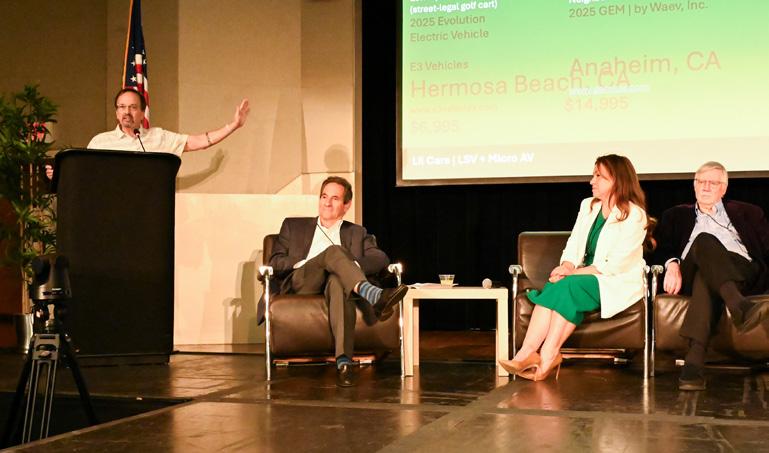
possibility of adding a second micromobility vehicle for local trips. Under his model those who part ways with “large car” ownership could potentially drive a micro vehicle to a local “mobility hub,” where “far cars” could be rented by the minute or hour for longer trips, as well as connect easily with public transit.
Despite its longevity, the tiny GEM car and its design contemporaries have remained on the mobility fringe. However, in recent years other newer types of microdevices, such as e-bikes and neighborhood electric vehicles that resemble golf carts, have surged in popularity—especially in South Bay coastal communities including El Segundo, Hermosa Beach, Manhattan Beach and Redondo Beach.
Sturges said historically are two main barriers to the full adoption of his micromobility dream: affordability and safety. He believes the GEM car, with a sticker price of close to $15,000, should instead sell for around $5,000—close to what an entry-level electric golf cart goes for.
Currently diluting the affordability concern is the math of car ownership cost over time. The American Automobile Association has estimated the annual cost of owning a standard gas-powered automobile to be more than $12,000 annually, but unlike full-speed electric cars, low-speed vehicles don’t require costly charging equipment upgrades at home. Houses and parking lots are already equipped for charging low-speed vehicles on normal 110V wall outlets.
On the safety front Sturges suggested creating better and safer bike lanes and

The Local Travel Network’s “rolling turtle” signage informs drivers when they are on the network in launch city El Segundo.
infrastructure for low-speed vehicle use. South Bay cities moved in this direction in 2023 with the launch of phase one of the Measure M-funded South Bay Local Travel Network (LTN) in El Segundo.
The SBCCOG and the city developed and launched the first-of-its-kind network to safely accommodate the use of micromobility vehicles as they share the road with traditional motorized vehicles. Streets on the route are marked with “rolling turtle” signage
Dan Sturges (at the podium), explains how integrated mobility options would help residents to live connected lives without owning a second automobile. Panel speakers, from right of the podium: Mike Jenkins, general counsel, SBCCOG, and moderator; Lujuana Medina, environmental initiatives division manager, SoCalREN, Energy Environmental Services, Los Angeles County; and Wally Siembab, research director, SBCCOG.
that notifies users they are on the network and provides wayfinding guidance to major destinations and safe intersections. The network will eventually span 243 miles of existing low-speed streets (25 to 35 mph) that will connect the South Bay as far north as Inglewood to as far south as San Pedro.
The SBCCOG’s own research on localuse vehicles supports the LTN project. The impetus for this research was the 2008 passage of Senate Bill 375, which required cities to combine local land use planning with transportation planning. This was on the heels of legislation and executive orders passed by then-Governor Arnold Schwarzenegger that addressed climate change. This includes the Global Warming Solutions Act of 2006, which aimed to reduce greenhouse gas emissions to 1990 levels by 2020.
In response, the SBCCOG developed a program called Local Use Vehicles, also known as the LUV project. It loaned out five electric small vehicles with a speed limit of 35 mph to local community members. Under the arrangement, the vehicles—each equipped with GPS—could only be used on local roads. The research revealed that 70% of trips taken in the South Bay are 3 miles or less, bolstering Sturges’ conclusions that “right-sizing” to smaller cars for short trips makes sense.
Work on the LTN’s next phase is underway in Redondo Beach, Carson, Lomita and Lawndale. The completion date for the Local Travel Network in its entirety has not yet been determined, but user feedback is currently being gathered in El Segundo to refine how it will be implemented in other cities. •
To watch the panel discussion in full, visit bit.ly/generalassemblyplaylist. For more about the LUV project at bit.ly/luvreport.
Thank you, sponsors and friends, for your generous support!
Benefactors
$5,000
Chevron Products Company • L.A. County Supervisor Holly J. Mitchell • Fabric Networks, Inc. • South Bay Association of REALTORS® • Southern California Edison • Southern California News Group (Daily Breeze, Beach Reporter, Palos Verdes Peninsula News)
Sponsors
$2,500
4LEAF, Inc. • AECOM • American Dark Fiber • California Water Service • Clean Power Alliance • Continental Development Corporation | Mar Ventures, Inc • GEO
SEARCH, Inc. • Los Angeles County Sanitation Districts • L.A. County Supervisor
Janice Hahn •
Metropolitan Water District of Southern California • South Coast AQMD • Southern California Association of Governments
• SoCalGas • Transtech Engineers • Water Replenishment District • Watson Land Company • West Basin Municipal Water District
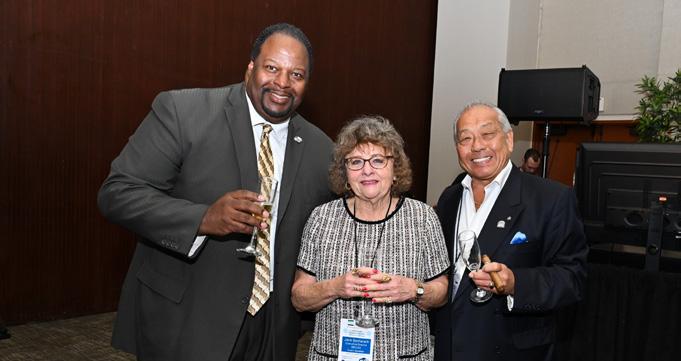
Cedric Hicks, Carson Council member and immediate past chair of the SBCCOG; Jacki Bacharach, executive director of the SBCCOG; and Rodney Tanaka, Gardena mayor pro tem and SBCCOG chair, raise a glass to celebrate the SBCCOG’s 30th anniversary.

Amanda Hansen, acting senior advisor for climate for the office of Governor Gavin Newsom, discusses the blueprint for a sustainable future in her presentation “Looking Ahead: How Cities and California Can Lead on Climate Resilience.”
Friends of the SBCCOG Beach E-Biking • Next Adventure E-Bikes • South Bay Workforce Investment Board • The Easy Reader • Wombi • Workbay, Inc. • Zislis Group
Special thanks to the City of Carson for hosting the event.
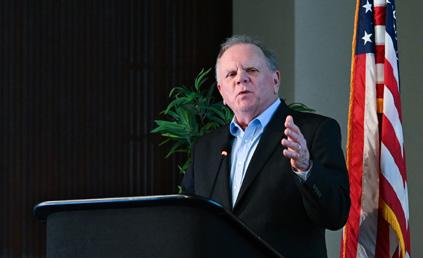
Terry Tamminen, CEO of AltaSea at the Port of Los Angeles and former secretary of the California Environmental Protection Agency during Governor Arnold Schwarzenegger’s administration, speaks on the topic “How the Blue Economy can Power a Sustainable Future.” He shares updates on AltaSea’s breakthrough research related to energy supply, climate change and global food security.

Zein Obagi, Redondo Beach Council member and SBCCOG board member, takes a spin on an e-bike at the General Assembly’s Ride & Drive micromobility event. Wombi, L.A.’s full-service e-bike subscription company, and EBikes2U, an Inglewood-based e-bike retailer, offered a selection of cargo e-bikes, e-scooters and accessories to try on-site.
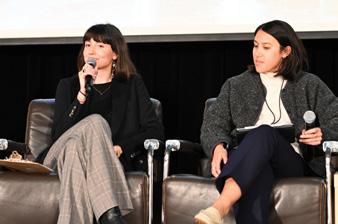
During the discussion “Insights from Tomorrow’s Leaders,” SBCCOG project coordinators Eleanor Murphy (left) and Miranda Werts share observations about the future of sustainability in the South Bay gained through their work with the SBCCOG’s environmental partners.
by Philicia Endelman
The California Association of Councils of Governments (CALCOG), representing 49 regional agencies across California, presented its Eureka Award to the South Bay Cities Council of Governments (SBCCOG) for its Functional Zero Street Homelessness Initiative. The Functional Zero program helps cities achieve measurable reductions in homelessness by ensuring more people are housed than become homeless. Redondo Beach recently became the first city to pilot and reach this benchmark.
The SBCCOG’s Homeless Services team coordinates housing placements, support services and real-time case management throughout the South Bay. In Redondo Beach, Functional Zero reduced street homelessness cases from 261 in 2017 to 25 as of mid-May 2025 while maintaining an average on-the-street duration of 14 days.
The Eureka Award recognizes California’s most innovative regional programs. The SBCCOG’s initiative stood out for its replicable framework combining housing solutions like pallet shelters and interim housing along with client aid. As three additional South Bay cities prepare to implement the program, the recognition highlights how regional collaboration can create scalable solutions to homelessness.
The CALCOG’s selection also highlights the SBCCOG’s leadership in developing practical, accountable approaches to one of California’s most complex challenges. The award validates the Functional Zero model as both an aspirational goal and achievable standard for communities statewide. •

Local Pizza Show Wins the South Bay 90s Rewind Photo Contest
For nearly 70 years, Hawthorne’s Pizza Show has been dishing out what it proudly calls “the best pizza, wings, pasta and sandwiches in the South Bay.” This family-owned institution, open since 1956, recently found itself in the spotlight as the winning subject of the South Bay 90s Rewind photo contest, hosted by the South Bay Cities Council of Governments (SBCCOG).
Lawndale photographer Giancarlo Guerra captured the pizza parlor’s timeless and iconic style in his winning shot. The photo showcased its vintage sign and storefront, where generations have gathered to enjoy meals and watch televised sporting events.
“I came about taking the photo of Pizza Show because of my memories of going there to eat with my parents and brothers in the early ’90s,” Guerra recalled. “Now as an adult, my friends and I enjoy ordering a giant pizza for lunch breaks.”
“Giancarlo’s photo captures exactly what we wanted to highlight—those enduring local landmarks that shape our community’s identity,” said Rodney Tanaka, Gardena’s mayor pro tem and SBCCOG chair, who frequented the pizzeria in high school. The contest invited submissions showcasing 1990s-era South Bay. It drew entries featuring street scenes, businesses and everyday life from the decade.
The pizzeria has been a neighborhood staple for generations, known for its late-night hours and gameday atmosphere. Owner Gary Evans, who took over the business from the original owner, his father, Jay, maintains the same recipes and traditions that helped Pizza Show stand the test of time. The pizzeria embodies the contest’s goals of celebrating timeless community classics.
Attendees of the SBCCOG’s 25th General Assembly in March were invited to select the winner among five finalists through an online vote. Tanaka announced Guerra’s photo as winner at the event. • For more information and to view the other finalists, visit bit.ly/90srewindwinner
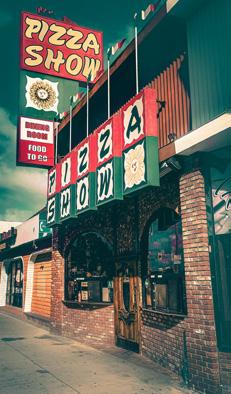
For the past 30 years the South Bay Cities Council of Governments (SBCCOG) has aimed to connect and support people and organizations of the South Bay subregion. So when it came time for the SBCCOG to develop a memento for attendees to take home from its annual General Assembly—which this year commemorated the organization’s three-decade milestone—it made sense to align with a local public school program that helps students whittle closer to their own career goals.
Hawthorne High School’s student-led Wood Technology Pathway gives students hands-on experience in traditional woodworking, cabinetmaking, residential construction, furniture design and computer-aided manufacturing. The SBCCOG approached Doug Galt, the school’s career and technical teacher who leads the program, to design a wood coaster featuring the SBCCOG’s logo. Galt and his students worked with the program’s laser engraver to produce 400 SBCCOG-branded wood coasters.
Pathway program participants can potentially earn up to 14 units of college credit at El Camino College. Advanced students of its paid internship program complete larger-scale, real-world projects for paying clients, such as the SBCCOG coaster project.
“It was a great opportunity for the students to get real work experience, serve the community and raise money for our program,”
The South Bay Cities Council of Governments’ outreach team and volunteers were out in full force at South Bay Earth Month events in April. The team works throughout the year to provide the community with information about the programs of its partners SoCalGas, Southern California Regional Energy Network, Water Replenishment District, West Basin Municipal Water District, Sanitation Districts of Los Angeles County, L.A. County Metro, and City of Los Angeles Department of Water and Power. Subject matter includes shared mobility options, telecommuting and traveler information, energy efficiency, water conservation, waste mitigation and recycling resources.
Look for the green canopy featuring the SBCCOG and South Bay Environmental Services Center logos at community events this summer and stop by to say hello.

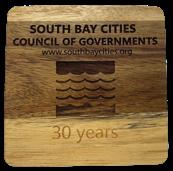
said Galt of the SBCCOG project and other paid projects. “Students also made great connections in the [General Assembly’s] exhibit hall that will lead to more business for our student enterprise.” •
To learn more about the Wood Technology Pathway, visit bit.ly/woodtechnologypathway



Brent Grisdale, CEO of Fabric Networks Inc., the new operator of the South Bay Fiber Network, shares his vision for growth
The South Bay Fiber Network (SBFN) represents a forward-thinking model of public infrastructure—built by cities, for cities. As we look ahead to what this network can become, Fabric Networks Inc. is proud to collaborate with the South Bay Cities Council of Governments (SBCCOG) in supporting a long-term vision for open access connectivity—one that enhances municipal operations, enables smarter public services and promotes regional collaboration.
As the new network operator, Fabric’s goal is to help transform the SBFN into a shared platform that cities across the South Bay can continue to rely on for decades to come. From traffic systems and emergency communications to park connectivity and civic buildings, the open access model of a municipal fiber optic network scalable to businesses and residents is designed to reduce costs, strengthen resilience and offer local governments greater flexibility in how infrastructure is used.
Open access means infrastructure is shared—not siloed—and operated for the collective benefit of its public owners. Fabric
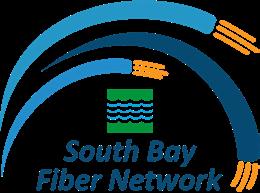
delivers network operator as a service, which includes 24/7 monitoring, cybersecurity, maintenance and network operations from our U.S.-based Network Operations Center. Our role is to provide dependable service delivery while enabling the SBCCOG and its member cities to remain in control of the network’s future.
What makes this model so promising is its blend of public governance and professional operations. Every participating city has a voice in how the SBFN evolves, and Fabric is here to execute that vision efficiently
and transparently. By removing technical complexity and centralizing support, we allow cities to focus on their priorities while gaining access to enterprise-grade performance.
Momentum is already building. The City of Gardena, for example, is actively expanding its municipal fiber to connect local park facilities and share that capacity through the SBFN framework. Gardena’s leadership demonstrates how cities can expand network reach and increase regional resilience through shared infrastructure.
With the possibility of state and federal funding still on the table for digital infrastructure and smart government initiatives, the South Bay remains well positioned to access and deploy resources quickly—should opportunities arise. Years of careful planning, fiber deployment and intergovernmental coordination have created a foundation that few regions can match.
At Fabric, we see the SBFN not just as a network of fiber but as a network of shared intent—a tool that can unlock value across departments, cities and communities. While we remain in the final stages of formalizing our role and agreements that will set the course for the SBFN’s future, we are committed to advancing this vision in partnership with the SBCCOG and its member cities. •
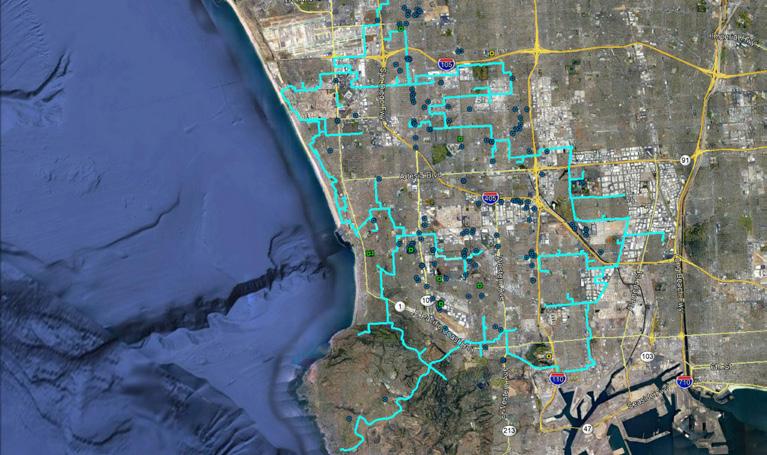
The South Bay Cities Council of Governments developed the South Bay Fiber Network’s core fiber ring (indicated in the map) through a 15-city municipal partnership. It provides an essential public resource to city governments and creates opportunities to bridge the digital divide in communities that are underserved with broadband.

The plant palette at 120 Via Colusa, a Sustainable Landscape Beautification Award winner, uses California natives and low-water Mediterranean plants. Manzanita ground cover slows runoff on a steeply sloped lot.
As SoCal water shortages remain widespread this spring, the lush green lawns that made up the residential landscapes of the South Bay’s past continue to shrink as residents gradually transition to more sustainable options like river rock, succulents and sage. But residents of Torrance are proving there is nothing aesthetically “dry” about drought-tolerant gardens, and the city is taking notice.
Torrance rolled out its residential Landscape Beautification Award this year to celebrate the efforts of residents who maintain and enhance their homes and outdoor spaces. Also recognized in a Sustainable Landscape Beautification category are homes that exhibit exceptional pride of ownership through water conservation practices as part of their landscaping design. This includes the use of drought-tolerant or native plants, water-friendly irrigation systems and energy-efficient lighting.
“Through this category, we hope to spread the word about what our fellow citizens are doing to help the environment right in their own backyards,” said Gregg Lodan, neighborhood services manager, Community Development Department, City of Torrance. “In turn we hope to inspire others to make changes in their own spaces.”
Nine properties throughout the city’s six council districts were selected as award recipients. Thirteen properties were selected for honorable mention.
The highest-scoring properties had several common features. They used a variety of plants, ground cover and even hardscape, such as pavers, patio spaces or decorative rock, to create a visually pleasing environment. They also used drip irrigation to minimize water usage, incorporated lighting to showcase their properties at night, and planted foliage to attract hummingbirds, butterflies and bees.
Lodan says the program aligns with the city’s strategic plan goals of appearance, character and quality of the community, and stewardship of the environment. Winners receive an award certificate, a yard sign to display and a gift card to a local home improvement store. Torrance plans to launch a Commercial Beautification Awards program later this year. •
To learn more about the program, visit torranceca.gov/beautificationawards
Residents throughout the South Bay, including Torrance, who convert their lawns to waterwise gardens, may be eligible for cash rebates from the water company serving their property. Anyone interested should contact their water agency for details. For more water conservation tips, visit southbaycities.org/water-conservation
South Bay Watch is a quarterly bulletin by the South Bay Cities Council of Governments to inform local leaders of subregional progress and alert them to emerging issues.
Governing Board: Chair
Rodney Tanaka, Gardena 1st Vice Chair
Bernadette Suarez, Lawndale 2nd Vice Chair
Bill Uphoff, Lomita
Immediate Past Chair
Cedric Hicks, Carson
Members:
Carson, Los Angeles County, El Segundo, Gardena, Hawthorne, Hermosa Beach, Inglewood, Lawndale, Lomita, Los Angeles, Manhattan Beach, Palos Verdes Estates, Rancho Palos Verdes, Redondo Beach, Rolling Hills, Rolling Hills Estates, Torrance
SBCCOG Executive Director
Jacki Bacharach
Legal Counsel
Michael Jenkins, Best Best & Krieger LLP Treasurer
Matthew Robinson, City Treasurer City of El Segundo
Editor
Colleen Farrell, Senior Project Manager, Communications Contributors
Rosemary Lackow, Administrative Assistant Zoran Trifunovic, CivicSpark Fellow Design
Vincent Rios Creative, Inc.
To subscribe to SBCCOG newsletters or view past editions, visit southbaycities.org/newsletter.
To view a schedule of SBCCOG meetings, visit southbaycities.org/calendar. southbaycities.org
Follow us: facebook.com/SBCCOG facebook.com/SBESC


@SouthBayCCOG @SBESC @southbayccog
